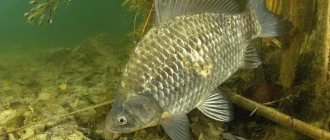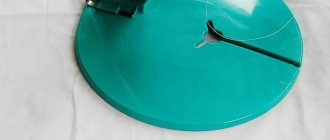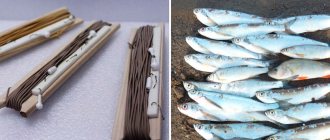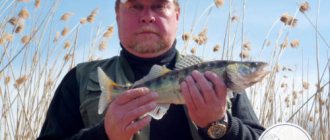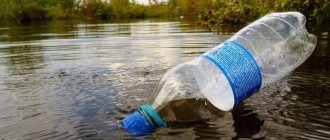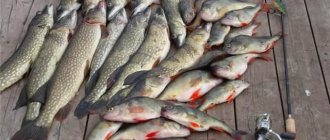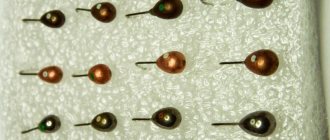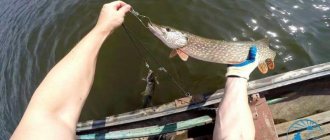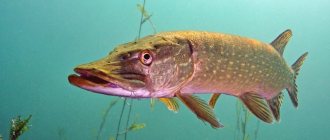When going to a pond with live bait, especially during periods of active hunting by predators, every fisherman can count on an excellent catch. The main thing is to assemble the tackle correctly and know the techniques for catching different types of fish.
The cast is performed once. Using an additional float and weight, we adjust the range and horizon for catching predators - these are just a few of the advantages of this fishing. Properly assembled gear, choice of fishing location and bait with bait - such knowledge will help a novice amateur catch a trophy specimen of pike or pike perch.
Elastic band diagram
Depending on the type and size of the trophies, you will need to make some changes in the thickness of the line, the size of the hooks and the length of the leashes. But the basic scheme of such equipment is the same for all types of bottom fishing rods. It got its name from the inclusion of a piece of rubber in the design.
Large cargo is transported by boat or thrown from the shore. A piece of nylon cord is attached to the sinker. A piece of 1-2 meters is quite enough for casting. Several meters of rubber are attached to the cord. The rubber insert is connected to the main line, on which leashes with hooks are located. All individual sections of the tackle are attached to carabiners.
This is a schematic, brief description of the gear. The main thing is to know how to make this type of gear for predators.
Coupling of the rubber band with the bottom
If the soil at the bottom of the reservoir is not very conducive to good adhesion to the rubber load (let’s say it’s sand), then I hammer pointed wooden pins into all the holes of the lead casting, protruding 1-1.5 centimeters on both sides of the blank.
(Wooden pegs can be whittled with a knife in a couple of minutes right on the shore from dry pine branches of suitable thickness.)
In this case, a load of any shape and weight on a fishing elastic band turns into an anchor and the problem of adhesion to the ground of the bottom of the reservoir of the blank will be solved.
A triangular-shaped weight in combat gear, designed for fishing on hard bottom soils, is shown in the photograph. But usually you have to fish on ponds, lakes and small rivers that have a muddy bottom, with which the casting sinker has no problems with adhesion.
Tackle elements
Any type, be it Astrakhan or classical scheme, is made of several parts:
- Reel . This part is required for stowing fishing lines and hooks when transporting or storing fishing rods. It can be made from a piece of board, plywood, dense foam or a piece of plastic panel. The main rule is that the entire supply of fishing line must be placed on it and the hooks must be securely fixed. All edges should be smooth so as not to cut the wood.
- Main forest . The choice of its cross-section depends on the size of future production and water transparency. If you take a thick line, you may not be able to wait for a bite from a cautious predator. But a thin forest will not be able to withstand the jerks of large prey. Therefore, it is important to maintain a balance. For catching small perches, a cross-section of 0.16-0.20 mm will be sufficient. For pike, it is better to set from 0.3 mm.
- Leash . The choice depends on the size of the trophies and their type. For pike you need to install a steel leash, but for perch a simple line or braided cord will be enough. The minimum number of them on one tackle is 5 pieces.
- Hook . When catching predators in places with possible obstacles, it is better to use offset hooks. Fishing from the shore or boat will require the installation of leashes with double or triple hooks. The choice of number directly depends on the size of the future trophy.
- Sinker . Normal conditions for catching predators depend on its size. If you plan to fish on a river with a strong current, multiply the weight of the load several times. It must withstand the load of water pressure and rubber tension while remaining in place. If you take the same sinker for pond fishing and perch fishing, you risk not delivering the tackle to the right place and, in general, tearing off the line when casting. But this rule only applies if you have to fish from the shore. A reliable boat will allow you to carry any cargo over a given distance. In order to remove such a fishing rod, attach a float to the carabiner on the cord on the line. This way, you can easily find the location of the sinker and quickly pull it out without unwinding or stretching meters of rubber when searching for the casting location.
- Rubber . For equipment, it is better to use round, as it was previously called “aviation” rubber, which can stretch 3-4 times. A rectangular section is not suitable. The sharp, thin edges quickly begin to become damaged and crack under frequent tension.
- Carbines, swivels . These parts make it easier to install the gear and prevent the leads from twisting.
Making your own tackle is quite simple. Let us examine in detail the manufacture of the basic donkey circuit.
Triangular shape of elastic band weight
For me personally, the optimal shape for a fishing elastic weight is triangular.
And I was tempted by the triangular shape of the weights for one simple reason: I’m used to fishing all the way, so I usually have to assemble the rubber shock absorber in the dark in the evening or in the morning in a hurry after a night of crucian fishing.
The triangular shape of the weight of the fishing rubber band (see photo) with a thick safety line ensures less hassle when pulling a lead blank of considerable weight to the shore of the reservoir.
But one more condition must be met, related to good adhesion of the lower plane of the blank to the surface of the bottom of the reservoir.
When fishing for crucian carp in a silted pond, a heavy lead weight of a triangular shape, optimal in my opinion, sinks deep into the loose soil and will hold the tension of the rubber band well.
The shape of the rubber shock absorber load is not so important in this case.
But there is one more important requirement for the load of fishing elastic: the blank must ensure reliable adhesion of the end of the bottom tackle to the ground in the place chosen for fishing.
Classic rubber band, live bait – do it yourself
Let's prepare for work:
- Big load. You can use lead braid from power cables or cast lead weights.
- Round rubber.
- Stock of main scaffolding of the required section.
- 5–6 leashes made of fishing line or steel thread.
- Reel.
- Hooks, carabiners and swivels.
Assembly steps
The work is carried out in several stages:
- At the 1st end of a meter-long piece of nylon cord we attach a load . In the middle we make a loop for the hand. This way, it will be easier for you to cast the tackle over a long distance.
- At the 2nd end we attach a carabiner to connect it with a section of the main line . Many people use a direct connection between the weight and the rubber, but this design will quickly come off. The length of the rubber insert depends on the casting distance. If the place is located 20-30 m from the shore, the rubber section should be 10 m or more.
- We attach a carabiner with a swivel to the end of the rubber . We connect it with a section of the main line, on which loops or carabiners are tied for attaching leashes. Depending on the species of fish or fishing conditions, the thickness and length of the leashes may vary. Every fisherman should have a supply of leashes with different hooks and sizes.
- We attach the leashes to carabiners or “loop to loop” . We knit spare leashes of different lengths and tie them to the hooks in a figure eight. If possible, it is better to use small carabiners or tie a loop at the end.
- We fasten the hooks . To do this, we stick them into the body of the donkey. If wood or plastic is used to make the reel, glue pieces of foam plastic to its edges and attach hook tips to them.
Our gear is ready.
Important! For successful fishing, experienced fishermen advise stocking up on fishing rods.
What to make an elastic band from
In principle, a weight for casting a fishing gum can be made from any metal that has a high specific gravity. The most common and accessible of them are copper, iron, and their alloys.
But the best choice for these purposes is, of course, lead. Making a lead weight for a fishing elastic is incomparably easier than cutting or sawing a blank from a steel plate.
For long-distance casting, the load should be flat and of considerable weight. The streamlined shape of the load after casting the elastic band experiences the least air resistance, which increases the casting range of the fishing elastic rig.
In addition, flat loads in flight have greater stability in space. Remember the flying saucers that hunters love to shoot at in competitions.
If the weight of the fishing elastic is made of a block (in the shape of a brick), then the stabilization of its position in flight will be the worst.
For this reason, after the brick lies on the bottom of the reservoir, we can get a twist of a rubber cord and a safety line next to the load, which helps to quickly rub the soft fishing elastic with the hard structure of the vein.
Next, we will analyze the requirements for the shape and weight of the fishing elastic load.
Choosing a place and time of fishing
You can catch large predatory fish with a rubber band, but landing the trophy will be difficult and memorable. To do this, it is important to know the best time, weather conditions, hunting and resting places for predators. Let's try to answer a few basic questions.
Where is the best place to fish?
The choice of fishing spot depends on the type of fish. While pike perch likes to hunt in areas of reservoirs with a sandy or rocky bottom, pike or perch prefer muddy surfaces. On a river or lake, the choice of location can be radically different. Pike prefers places with a steep bank. Her favorite places are small creeks, bays, and snags. But for elastic fishing, it is better to find a point on the border of clear water and thickets of aquatic vegetation.
Pike perch will be attracted to a small bay with calm water or an island in the middle of a large river with a sandy bottom. In any of these places there are sure to be schools of young peaceful fish, hunting for which a predator comes out.
What time of year and day?
There are 2 periods in the year when fishermen forget about all household chores. This is the time of spring feeding, when predators are actively feeding after winter, and you can go fishing at any time. Pike or pike perch approach places of accumulation of peaceful fish that are gaining fat. During this period, the best place for fishing is the confluence of meltwater streams, from which food for prey and oxygen enter the reservoir.
The second time of active fishing is pre-winter. The first drop in temperature causes predators to become more active and begin to gain fat before winter. The time for autumn food is coming. A rubber band for pike or perch allows you to quickly secure an excellent catch and gives pleasure when fishing for a strong opponent.
Summer is the time when fish are caught in the wee hours. The water has cooled, large individuals go hunting, and small ones return from night fishing. If the fisherman manages to find the place where they meet and throw the rubber band at the right time, the result is guaranteed. In general, summer is a time when predators slide into deep holes with cool water and hunt in the rare hours of dawn.
But if there is a sudden drop in temperature, predators try to catch up and become more active.
Influence of weather conditions
Everything is simple here. If a north or east wind blows, it is better for fishermen to stay at home. Powerful southwestern or western winds blow, you can safely go fishing. Strong excitement lifts crustaceans and other food of peaceful fish from the bottom, and it begins to actively move throughout the reservoir. The predator will definitely react to this.
High atmospheric pressure - the fish will be passive and difficult to find. This is due to a decrease in the amount of oxygen in the water. The fish rolls into deep holes with springs and stands there. Catching pike perch with an elastic band will be successful and effective if strong waves push the thermocline away from the shore. Warm water sinks into the depths, followed by schools of small fish. At the depths they will be guarded by fanged predators.
Fishing elastic leash length
The length of the fishing elastic leash depends entirely on the fishing conditions in the body of water chosen for fishing. But in any case, the nozzles on the hooks of the leashes should not be located too close to the main line of the fishing tackle.
And at the same time, the excessive length of the removable leash should not contribute to the interlocking of hooks tied to adjacent fishing elastic leashes.
If you assemble a fishing elastic according to my recommendations, then the length of the leashes on your elastic from the attachment point to the hook should not exceed 30 cm, taking into account that the length of the section of the supporting line between adjacent swivels is 60-65 cm.
As for choosing the length of a removable leash in accordance with the fishing conditions in a particular body of water, I suggest you read my material on another page of this topic.
Long leashes will be needed if the fish feeds from the bottom, and the working section of the fishing elastic is stretched over the hole.
Follow the link and pay attention to the first picture. Then it will become clear how the length of the leashes attached to the fishing line of a fishing rubber band can play a cruel joke on us when fishing.
Although in this example it is not the too short length of the leashes that is to blame, but the incorrect equipment of the fishing elastic.
Fishing technique and tactics
For effective fishing, you need to cast to the right place and not lose your gear. It's good if you have a boat. Then the casting issue is easily resolved. We unwind the tackle, go by boat to the desired place and lower the sinker. In this case, in order to easily remove the load from the water, we tie a line with a bright float to it. Now after fishing you can easily find and remove the cargo from the bottom. Successful fishing for pike perch is possible even in urban areas, especially when predators go to spawn.
Let's take a closer look at the fishing technique if the boat is inaccessible to the fisherman:
- We unwind and carefully place the elastic band and the main line on the ground . In order not to lose the tackle when casting, we unhook the carabiners, lines and leashes in the area between the main conductor and the elastic band and connect these parts directly.
- Having unwound and laid the line and elastic in a clean place, we take the cord with the load by the loop and throw the donkey to the place you like, or rather, a little further . It is important that after the rubber is loosened, the hooks are on the border of vegetation and clean water.
- We drive 2 pegs into the soil . One is near the water, and the other is 4–5 meters from it. The second one will be used to secure the tackle when replacing bait and live bait, and the first one will serve as a support for installing a bite alarm. Signaling devices are used in different ways. If we go night fishing, it is better to use a luminous or electronic bell that indicates in the dark which gear has worked. During the day we use a simple bell or a lump of damp soil stuck on the wood.
- We select the line from the water to the point where it connects with the rubber . Before disconnecting the carabiner, we recommend fixing the elastic band so that it does not go into the water if you move it carelessly.
- We attach a section of the line with leashes with carabiners, and gradually release the line . When it loosens, we can determine whether the cast is correct. But we are in no hurry to make adjustments. We take the hooks out of the water and attach live bait or bait.
- Only now can you adjust the casting and finding the hooks. If the leashes do not reach the site a little, we attach a float in the front part of the main line; it increases the range of lowering the hooks to the bottom. If the tackle is thrown with a flight, on the far side, near the last hook, we hook sheet lead. The additional weight lowers the bait exactly to the intended location.
- Self-made equipment allows you to install the required number of hooks. Right on the pond, by quickly unhooking the leash with a large hook and setting a smaller number, you can catch perch if the pike perch doesn’t want to bite today.
- We carefully begin to reel in the slack in the line , after we feel a slight tension, we fix the cord on the first peg. We attach the alarm and move on to casting the next tackle.
- After the bite, we wait for a new series of jerks. We hold the line in our hand and cut smoothly and carefully.
Important! Don't forget to pack an extractor and a reliable yawner in your backpack. This way you will protect your hands from the predator’s teeth and quickly remove the hook from the fish’s mouth.
How to fish with an elastic band correctly
Date: May 26, 2021 | 843
I’ll tell you straight that even the mention of such gear as an elastic band, like a donkey with a rubber shock absorber, makes me smile nervously and have some semblance of micro-tremors. An experienced psychologist who can read gestures would clearly say that I don’t really like this tackle. And this is the honest truth. I will mention the reasons for this reaction later. But, we must admit that in some situations, an elastic band is extremely relevant. And it makes sense to tell beginners how to fish with an elastic band correctly, how to make it with your own hands, what subtleties there are in this matter. This is what this article is about.
So, what is donka? This is a tackle, logically, for catching fish from the bottom. And in its simplest form, it is a fishing line with a sinker at the end. And above or below the sinker there are one or more leashes with hooks. The hook is baited with bait, the same worm, or something more interesting. Donka is thrown into the water. The fishing line is pulled and bites are monitored using various devices, even down to simply holding the fishing line on your finger.
What is a donk with a rubber shock absorber, or simply “rubber band”? The basis of the tackle is a reel, or a pole with a reel. Yes, an elastic band is that rare tackle where a rod is, in the full sense, unnecessary and unnecessary.
In the simplest version, the elastic band is assembled on a reel made of plywood or some other suitable material. Usually there is a double reel. One pair of recesses is for winding the main gear, and the second is for an elastic band.
There are also reels combined with a pole stuck into the bank. Or, the elastic band is collected on a reel mounted on a pole.
If you just use a reel, then to fix the tackle, cut out a flexible branch on the shore. They make a split in it from above and stick it into the bank.
What does the elastic band consist of and how is it assembled?
The main line is taken quite thick, rarely thinner than 0.28mm. Usually, within 0.3-0.45mm. Firstly, you don’t need to be particularly camouflaged, because due to thin leashes there is no point in thinning out the main fishing line. Secondly, all work with the elastic band is done by hand. And it is inconvenient to use a fishing line that is too thin. In the end, you can cut your hand.
The main line can be of different lengths. It is clear that if the elastic band is thrown manually, then a reserve of 50-60 m is more than enough. But some people bring rubber bands by boat. And here, in theory, you can make the tackle more extended. Although, I don’t know the meaning of this. The tackle is selected and cast by hand. Fishing with an elastic band that is too long will turn into a tedious task with an extremely slow pace.
Next, at the end of the main line there is a section with hooks. There may be options here. Either the hooks are tied directly to the main fishing line, through loops or small swivels connected to it, or an insert is made, say, from a fishing line that is a little thinner than the main one. How to splice two fishing lines.
This section itself is chosen as long as many hooks are used. I know maniacs who fish with elastic bands with 20 hooks. But looking up to morons is bad form. Personally, I catch elastic with 3, rarely with 4-5 hooks.
Leashes for elastic bands
The thickness of the leashes for rubber tackle, of course, largely depends on the fish we are going to catch. For example, for a small crucian carp, for some kind of linen, you can use a fishing line or fluorocarbon with a thickness of 0.12-0.15 mm. For large crucian carp, medium carp, tench, up to 0.2mm is possible. It happens that predatory fish and live bait are also caught with rubber bands. And here you can even hang metal leashes. If, nevertheless, they use a fishing line leash, then it is not too long, usually 10-15 cm, sometimes up to 20 cm. A hook is tied at one end of the leash, and a loop is formed at the other (with a double knot, or a figure eight knot). And, using the loop-to-loop method, leashes are attached to the tackle. Some fishermen immediately equip the elastic with leashes with hooks, others keep the leashes on a separate reel or reel. If the leashes are permanently left on the elastic band, and not removed after each fishing trip, then one improvement needs to be provided. When knitting loops on the main fishing line or insert, after each loop a piece of insulation from a thin wire is put on the fishing line. The hook tip is then inserted into it. This way you can wind and unwind the tackle without getting tangled with fishing line, leashes, and hooks.
Distance between rubber bands
Obviously, the distance between the hook attachment points should be slightly greater than two leash lengths. Please take this point into account when assembling the gear.
Next, at the end of the fishing line or insert with hooks, an elastic band is attached.
How to tie an elastic band to a fishing line
Since it is practically impossible to simply tie a fishing line to an elastic band reliably, some kind of transition element is used. It could be a swivel. A fishing line is tied to one ring of the swivel, and an elastic band to the other. It is advisable to protect the gum with a cambric. The elastic band is folded in half and knitted with regular knots.
The swivel works great as an intermediate link. In addition, it slightly eliminates the twisting of the fishing line and the winding of leashes on the fishing line.
But, there is another original way of attaching an elastic band to a fishing line. Through a button. We just take an ordinary small shirt button. And we tie a fishing line into one hole and an elastic band into the other.
Elastic length
The length of the elastic band is taken to be approximately 2-2.5 times shorter than the working length of the fishing line. In truth, it is necessary to test, because... There are different rubber bands on the market. Both in thickness and stretchability. To check everything for yourself, you need to clearly configure the gear.
A sinker is tied to the end of the elastic band.
Sinker for elastic band
The most common type of elastic sinker is a spoon. Simply cast a lead sinker in an ordinary tablespoon. Let's just say, with a small “slide”. Such a load holds, and with a little more effort it comes out to the fisherman. But, of course, you need to test on different types of bottom. Somewhere on the sand such a load can be pulled up, but on muddy or sparse grass it is optimal.
If the elastic is brought in or insurance is used, for example, and there is no idea of pulling it out on the tackle, then you can use a obviously heavier load. It could just be some piece of metal, an old hammer, etc.
Usually the elastic band is tied to the sinker not directly, but through a piece of rope or thick twine. Firstly, it’s more convenient. Secondly, if anything happens, you can throw the tackle by unwinding the sinker on the rope, like a sling.
One important technical nuance. Somewhere in the area where the main line goes into the insert with the leads, a fairly large loop is knitted. On the shore, approximately at a distance from the water's edge equal to the length of the area with leashes, a peg is stuck. When the elastic band is pulled out to load the hooks with a nozzle, the tackle is fixed by putting a loop on the peg.
This makes it much more convenient to work with hooks and bait than to hold the tackle with one hand and tinker with something with the other. Besides the inconvenience, it is also a safety issue. If the tackle comes off, being carried away by the elastic, it can embed hooks into your flesh.
What variations can there be in the configuration of the rubber band tackle ?
There may be an option when the gum is brought in by boat. Then, to find the sinker after fishing, they use a buoy, some kind of float, which is tied directly to the sinker. Having caught, the fisherman approaches the buoy in a boat, takes out a sinker, and, approaching the shore, collects the tackle.
In addition, you can use the buoy to determine whether the cargo is being pulled towards the shore. And also, you can throw the bait more precisely along the line from the tackle to the buoy.
There may also be an elastic band option - with insurance . That is, in addition to the main tackle, insurance is directly tied to the sinker - a strong fishing line or cord. Then, without risking leaving the sinker at the bottom, you can pull it out directly behind the belay.
Some unique people even manage to throw something like this... But, still, it’s better to bring it by boat.
You can also place the feeder in the place where the elastic band is attached to the fishing line. Then feeding will generally be targeted, clearly along the path, along the line where the hooks will be.
If it is necessary for the hooks with the nozzle to be raised above the bottom, then you can place a float at the place where the elastic band is attached to the fishing line.
So, we figured out the technical side of the elastic band. Now let's talk about when using an elastic band is justified.
Usually crucian carp are caught using an elastic band. On the one hand, you can fish at a fairly large distance from the shore. Feed accurately and precisely. In principle, in matters of sensitivity, the elastic band is quite good. In any case, it is much more sensitive than an ordinary donka.
But, you can catch pike, large perch, and pike perch with live bait using an elastic band.
How to catch elastic with a tackle
Well. We come to the shore of a reservoir. If we are going to bring gum on a boat, then everything is simple. The risk of tangling the tackle is minimal, you can put it where you need it, for as long as you need it, and place it very precisely.
We throw or bring in gear, but the leashes either have to be removed, or the hooks are hidden in the cambrics.
But, if we throw gum, then we need to prepare the site. This should be a section of the shore clear of debris and branches. If this is not the case, then lay it down with oilcloth, a rag, or newspaper.
Well, we unwind the sinker, or swing it - and launch it. This requires some skill. I admit honestly, I used to throw the rubber band into the crowns of trees, and to the side, and in the wrong place, and even behind my back. Well, there were some successful attempts. So, I don’t really like the elastic tackle because of the slow pace of fishing, the inability to quickly move and look for fish, and for such difficulties with casting.
The sinker is at the bottom. The fisherman either inserts a separate pole - a flexible twig, or the tackle itself, if it has a peg. We stick a peg behind to secure the gear. Choosing a fishing line. Place the loop on the peg. Now that the tackle is fixed, you can attach leashes, if we have them separately, or remove the hooks from the protective casings. Place bait on the hooks. This could be a worm, maggot, other animal bait, or some kind of plant bait.
We remove the loop from the fixing peg and smoothly, so that the nozzle does not fly off, we begin to release the fishing line. The hooks go into the water. When the elastic has completely compressed, adjust the length of the working line. Now all that remains is to hang up the bite alarm.
The simplest bite alarm is a piece of twig with a split. You can also use a lead weight or clothespin. A more advanced option is a bell on a clothespin.
The first task of the alarm is to hang on the fishing line, tighten it, ensuring a minimum of sagging and increase the sensitivity of the gear. The second, in fact, is to record the bite. When biting, the fish either twitches the alarm or drops it.
Here, in fact, we sit and wait for a bite. This tackle is good because some tension is achieved due to the elastic band itself. This increases sensitivity. You need to sit closely near the tackle and hook instantly, pulling the line with your hand.
It is often possible to catch much more crucian carp or whitefish with an elastic band than with simple float rods.
But, the elastic tackle also has disadvantages. In addition to difficulties with casting, which obviously not everyone experiences, one can note the low fishing rate and problems when relocating is necessary. Also, in any noticeable current, the elastic band does not work well. In general, the tackle, to put it mildly, is not for everyone. But they exist, and there are many of them. If you are interested in this gear and have read this review, you may be one of them.
* * *
AND YES! Just think about it! This is the 990th article on my blog. 10 more publications and we will reach the second thousand. The site is almost 6 years old. I was quite active, and there were moments of downtime. Anyway, happy upcoming anniversary everyone. And who has not yet subscribed to new articles - do so immediately! This can be done by entering your email in the form below, right under the social network buttons.
Share with your friends:
Category: Spin-Don-Pop:)
Tags: Donka, Crucian carp, Rubber band, Alarm, Tackle
Brief recommendations for catching different types of predators
For perch fishing, we recommend using an elastic band with a cross-section of up to 5 mm. Single hook No. 8. The main line is 0.3-0.4 mm, the leads are monofilament 0.25 mm. You should not put more than 7-8 hooks, otherwise such equipment will not increase the catch, but will increase the consumption of bait and the risk of tangling the gear.
Fishing for walleye will require heading to rocky or sandy flats with minimal vegetation. If a predator refuses to bite, try looking for it in the depths. He likes to hide in holes (minimum 3000 mm) with clear water and a rocky bottom.
But you will have to make small changes in the design of the equipment, take an additional sinker weighing 35 g. We make it a sliding type and place it in the space between the rubber and the first leash assembly. The leashes are also sliding, we fix their movement with 2 beads installed at a distance of 500 mm from each other.
Fishing for pike with an elastic band is a gambling activity. Spring pike fishing in muddy water allows you to hook leashes of the same section as the main line. The distance from the end of the rubber to the first leash is from 6 m. It is better to raise such tackle above the bottom. To do this, we fix small floats in the space between all the leashes, which lift the hook with bait and the pike will see the bait at a long distance.
Catching predatory fish will be effective if you use several types of baits in one tackle.
Baits and lures
Well-made equipment is only half the battle. Fishing will be successful when you manage to guess the taste preferences of predators. For bait, use only those species of live bait that live in the reservoir. They must be strong and remain alive and mobile for a long time. We do not recommend planting rotan, such live bait will not attract predators, although it is tenacious. For live bait it is recommended to use:
- crucian carp;
- small perches;
- roach;
- ruffs;
- rudd.
The main thing is that the bait is fresh and active. They hook the bait in different ways. Many fishermen recommend hooking single hooks into the upper jaw. Some people like to hook single hooks and other types of hooks under the dorsal fin on predators. There is a way to thread the line through the gills and after removing the leash from the mouth, tie a hook or secure it with a carabiner.
In the fall, predators prefer passive prey, saving energy to accumulate fat in the winter. During this period, you can use sprat and pieces of fish for bait. It is better if the bait has mirror scales so that predators can see prey from a distance. You can tie jigs or small spinners, especially for catching perch. Such baits arouse interest with their game and the smell of the bait.
The introduction of animal complementary foods in combination with the addition of industrial attractants for predators will increase the catch, but such complementary feeding is not needed for active fish.

